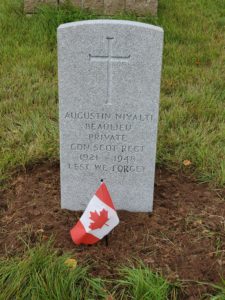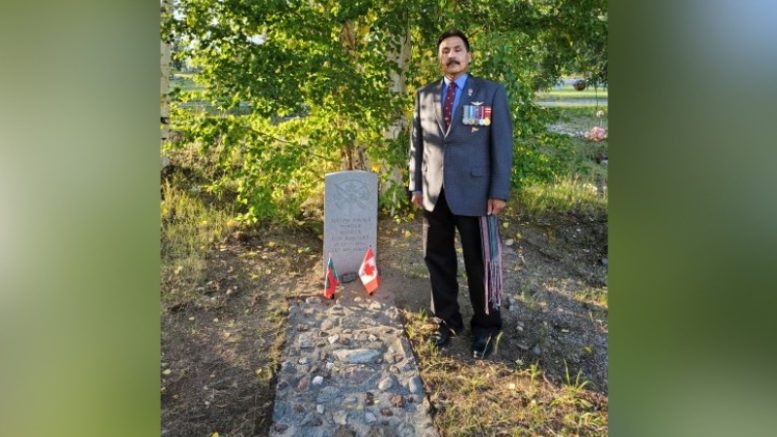The families of Indigenous veterans — especially in small communities — may not know they are eligible for funeral and burial assistance from the military, says Floyd Powder.
That can lead to the veterans being in unmarked graves without a headstone recognizing their service.
Since May 2020, Powder, an Indigenous veteran that served 32 years and originally from Fort Smith, has been tracking down unmarked graves of veterans across the NWT and working with families so their loved ones can have a military-style headstone.
He does this volunteer work through the Last Post Fund’s Indigenous Veterans Initiative. While the project focuses on finding Indigenous veterans, Powder is mostly working alone and will identify any unmarked veteran graves.
Powder became aware of the initiative in October 2019. Federal representatives of Veterans Affairs were in Yellowknife and Powder organized a handful of local veterans to meet with them. During the meeting, Powder mentioned that some Indigenous veterans were laid to rest without a proper headstone. The representatives told him about the initiative, which had started earlier in the year. Powder then messaged some of the Legions across the territory and other organizations to inform them of the program.
A few months later, he received an email from the program’s coordinator asking him to check the graves of two Indigenous veterans at Yellowknife’s Lakeview Cemetery.
“I walked every headstone, front and back to verify and I couldn’t find the two veterans that they were looking for,” he says.
He started his search at the cemetery’s veterans field of honour and noticed there were eight bases without headstones.
“That struck me as odd and when I checked again, there’s veterans actually buried there… To me that’s wrong,” he says.
That experience is what started his involvement as a volunteer researcher working to track down graves.
So far, the fund has helped install 25 headstones ranging from Fort McPherson to Fort Fitzgerald. Of those, 13 have been for Indigenous veterans.
Left unmarked
Powder says Indigenous veterans in small communities can be “overlooked” since they’re often not a member of a local Legion. If they pass away, the family may not be aware their loved one is entitled to certain benefits stemming from their service.
However, Indigenous veterans were also not always welcome within Legions.
Nov. 8 marked Indigenous Veterans Day in Canada. It’s estimated more than 7,000 First Nations people served in the First and Second World Wars in uniform. The federal government says that number is higher when considering “an unknown number of Métis, Inuit and other Indigenous recruits.”
Despite this, Indigenous veterans were not allowed to salute lost comrades — including during Remembrance Day — at their Legion until 1951. And that was only if the Legion allowed it. And still it wasn’t until the mid-90s that Indigenous veterans were finally allowed to lay wreaths at the National War Memorial in Ottawa.
With rules like these in place, it’s no surprise Indigenous veterans may have ended up in unmarked graves and forgotten by the Canadian Armed Forces.
Powder says a recent change in the definition of “veteran” could also lead to people not knowing their loved one is eligible for support.
In the last decade, the Canadian Armed Forces changed the meaning of “veteran” to: Any former member of the Canadian Armed Forces who successfully underwent basic training and is honourably discharged.
“So that opens the door for a lot of modern day veterans,” says Powder.
Until realizing this change, Powder says he didn’t consider himself a veteran, thinking the term was reserved for people that served in the WWI and WWII, and the Korean War.

Augustin Niyalti Beaulieu was a private that had an unmarked grave in Yellowknife’s Lakeview Cemetery. (Photo courtesy of the Last Post Fund)
Working with families
Once a grave is found, Powder works with the community and family to see if they’d like to have military-style headstone.
Some of the considerations for the family are whether to include an Indigenous symbol on the headstone and have the name written in a traditional language.
An information sheet on the initiative says there are seven symbols to choose from, including a bear, eagle, a feather, or medicine wheel among others. It also says families have asked for names to be spelled in six Indigenous languages so far: Algonquin, Blackfoot, Cree, Interior Salishan, Inuktitut and Saulteaux.
Over the summer, thousands of unmarked graves were identified on the sites of former residential schools.
CKLB asked Powder if he saw any connection between his work in tracking unmarked veterans and the graves at former residential schools.
“For me, they’re two totally separate situations,” he said.
Anyone who served in the military has their record with Library and Archives Canada. In the case of residential schools, the documents can be held by many different organizations or governments — if they still exist.
He says that distinction is “a big difference.”
Powder is attending this year’s Remembrance Day events in Ottawa as a representative of Aboriginal Veterans Autochtones. He also recently received two of his father Eddie Powder’s military medals and will ask an Elder to bless them at the ceremony.
When he returns to the NWT, Powder plans on making a trip to the Beaufort Delta next spring to look for unmarked veterans’ graves in the region.





